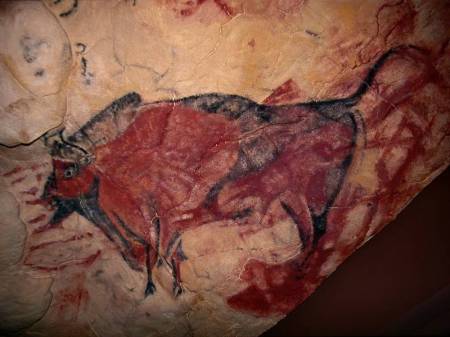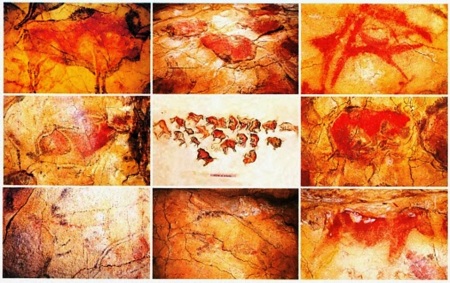“I visited the Cave of Altamira while traveling in Europe with two friends in 1968. Once inside, I was of course in awe, not only of the age of the paintings, but also of the delicacy and skill with which they had been executed. I think we tend to look down on our distant ancestors as primitive and stupid, but cave paintings like those at Altamira remind us that they were not.” Susan (Washington) – Blogger
The “Twelve Treasures of the Kingdom of Spain” was a contest/poll that was conducted by the Spanish Television Company Antena 3 and the radio broadcaster Cope. The final results were announced on 31st December 2007. I thought it might be interesting to take a look at the eight out of the twelve that I have visited. Second in the competition were the prehistoric cave paintings of Altamira.
On the final morning of my visit to Santillana del Mar the weather proved to be a disappointment, I could hear rain on the window as I started to stir and when I did the weather check I could only report back that the sky was grey and it was drizzling. At breakfast our host confirmed the worst and informed us that the forecast was gloomy all day so we decided that it was probably a good day to go and do something undercover and perhaps visit a museum.
After breakfast we settled up and said goodbye and headed back towards Santillana Del Mar and then followed signposts to the Altamira museum on the edge of the town. I wasn’t expecting a great deal to be honest so was surprised to find a very big car park and a large building built into the hills. I was about to learn about something else that I was completely unaware of – Cantabria is the richest region in the world in archaeological sites from the Upper Paleolithic period (that’s the Stone Age to you and me). The most significant cave painting site is the cave of Altamira, dating from about 16,000 to 9000 BC and declared, with another nine Cantabrian caves, a UNESCO World Heritage Site.
Well, you learn something new every day it seems!

Around 13,000 years ago a rockfall sealed the cave entrance preserving its contents until its eventual discovery which was caused by a nearby tree falling and disturbing the fallen rocks. The really good bit about the story is that it wasn’t discovered by Howard Carter, Tony Robinson or Indiana Jones but by a nine year old girl who came across them while playing in the hills above the town in 1879. Her father was an amateur archaeologist called Marcelino Sanz de Sautuola and he was led by his daughter to discover the cave’s drawings. The cave was excavated by Sautuola and archaeologist Juan Vilanova y Piera from the University of Madrid, resulting in a much acclaimed publication in 1880 which interpreted the paintings as Paleolithic in origin.
So well preserved were the paintings however that there ensued an argument about authenticity and some believed the whole thing to be a hoax and it wasn’t until 1902 that they were eventually accepted as genuine.
We paid the modest entrance fee of €2.40 and went into the museum, which turned out to be a real treasure with interesting displays about the Stone Age, or the Paleolithic period if you prefer, with the highlight of the visit being a full size recreation of the original cave and its precious paintings. Today it is only possible to see this copy because the actual cave is now closed to vistors. During the 1960s and 1970s, the paintings were being damaged by the damp breath of large numbers of visitors and smoke from Fortuna cigarettes and Altamira was completely closed to the public in 1977, and reopened with only very limited access in 1982.
Very few visitors are allowed in per day, resulting in a three-year waiting list. It would be nice to go into the actual cave but actually the replica allows a more comfortable view of the polychrome paintings of the main hall of the cave, as well as a selection of minor works and also includes some sculptures of human faces that cannot be accessed in the real thing.
And, let me tell you, these people were really good painters. The artists used charcoal and ochre or haematite to create the images, often scratching or diluting these dyes to produce variances in intensity and creating an impression of remarkable and sophisticated contrasts and they also exploited the natural contours in the cave walls to give a three-dimensional effect to their subjects.
The painted ceiling is the most impressive feature showing a herd of bison in different poses, two horses, a large doe and a wild boar. Other images include horses, goats and hand prints created from the artist placing his hand on the cave wall and spraying paint over it leaving a negative image of his palm.
Numerous other caves in northern Spain contain palaeolithic art but none is as advanced or as famous as Altamira.
The entrance to the real cave is not so impressive however…




![altamira[1]](https://apetcher.wordpress.com/wp-content/uploads/2013/02/altamira1.jpg?w=450&h=318)


Pingback: Twelve Treasures of Spain – Altamira Caves at Santillana del Mar | Home Far Away From Home
Quite amazing! I was going to skip this one as I’m not fussed on caves, but I popped in to say “ah, this is one of your surprises”, and so it is!
What was the winner then, Andrew? Not Cordoba, I expect. Ok, I’ll contain my soul in patience, as Mam always used to say.
LikeLike
Actually yes it was Cordoba. I should have done the countdown like ‘Top of the Pops’ but on this occasion I inexplicably started with number 1. Altamira was no. 2 and that surprised me!
LikeLiked by 1 person
Pingback: Weekly Photo Challenge: Off-Season | Have Bag, Will Travel
It’s amazing to think that somebody did that all those thousands of years ago.
LikeLike
and in the dark by firelight!
LikeLike
Interesting bit of history and that is some creative ways sketching on the walls of the caves, such as spraying paint over their hands…then again, I wonder what sort of spray cans were there back then.
LikeLike
They could probably teach us a thing or two!
LikeLiked by 1 person
What a nice surprise, coming upon this fascinating example of prehistoric art! I think I may be a direct descendant of some of these ancient humans, because I have always been partial to wall art, and this old work gives me shivers. I was once doing some volunteer work in France, and our fabulous old patriarch, Henri Gignoux, pointed to a trail off the site in Gaujac and gave a long speech in French. I politely listened with the other volunteers. A bilingual member of the staff translated the whole speech to a single sentence: “There’s a cave down that trail.” I didn’t think much of it after that. I’ve seen caves before. Gossip that evening told more of the story, from people who understood French, unlike me. It was a cave, with prehistoric paintings on the walls! Not far from the site of Chauvet Cave, I can only imagine what I missed by not asking to walk down the trail. What I missed by not understanding French.
LikeLike
I visited some more caves in Spain – Cuevas del Aguila. No paintings this time but a fascinating story about how they were discovered by small boys playing in the woods who squeezed themselves down an unlikely hole and came across a series of magnificent chambers. Fortunately there is a proper entrance these days for visitors.
LikeLiked by 1 person
I am grateful for all the times when caves were preserved, rather than slowly degraded by exposure. Thank goodness for exploring boys!
LikeLiked by 1 person
Pingback: Travels in Spain – UNESCO World Heritage Sites | Have Bag, Will Travel
Pingback: On This Day – Santillana Del Mar in Cantabria | Have Bag, Will Travel
Only a three year wait . . . had you applied, you could have visited it four times by now.
LikeLike
Good job I didn’t book for this year!
LikeLike
Fabulous. These look even better than the caves at Niaulx in the French Pyrenees which you are still allowed to visit. That window shot of yours puts mine in Cádiz, which you admired yesterday, in the shade!
LikeLike
I had never heard of this place. Imagine being on the 3 year waiting list and your turn was this year! Despite it being a replica it looks great. Better than the real thing we saw in Azerbaijan for sure!!
LikeLike
It is a really clever way to show what most of us cannot see.
LikeLiked by 1 person
What a treasure !
LikeLike
It was brilliant Jon, all the better for not knowing about it beforehand.
LikeLike
What a find! And how interesting.
LikeLike
It certainly was and I am so glad that it rained that day or I would have missed it!
LikeLiked by 1 person
A very good record of cave paintings I’d never heard of
LikeLike
Thanks Derrick. It is an impressive place for sure.
LikeLiked by 1 person